
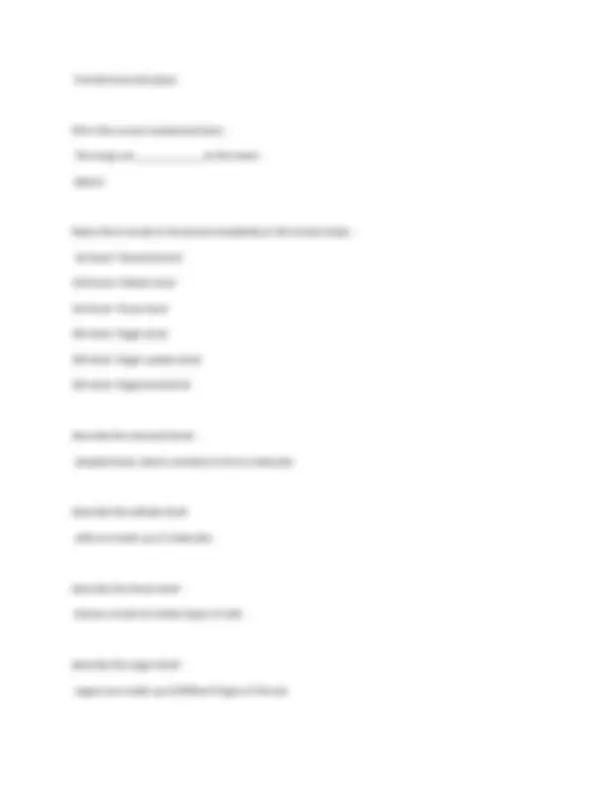
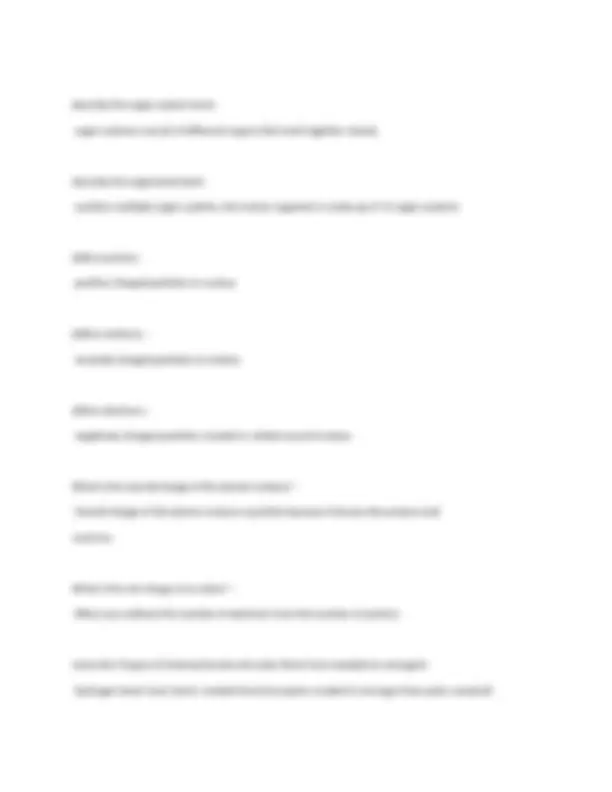
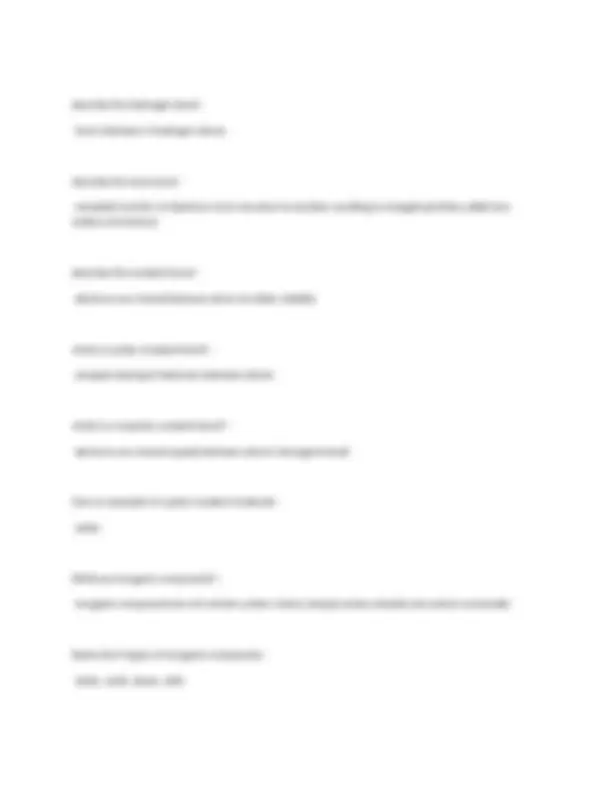
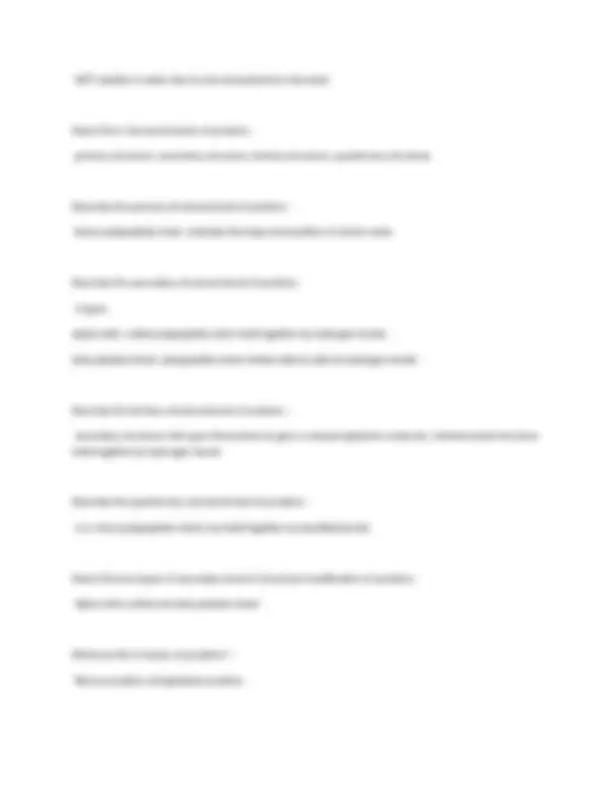
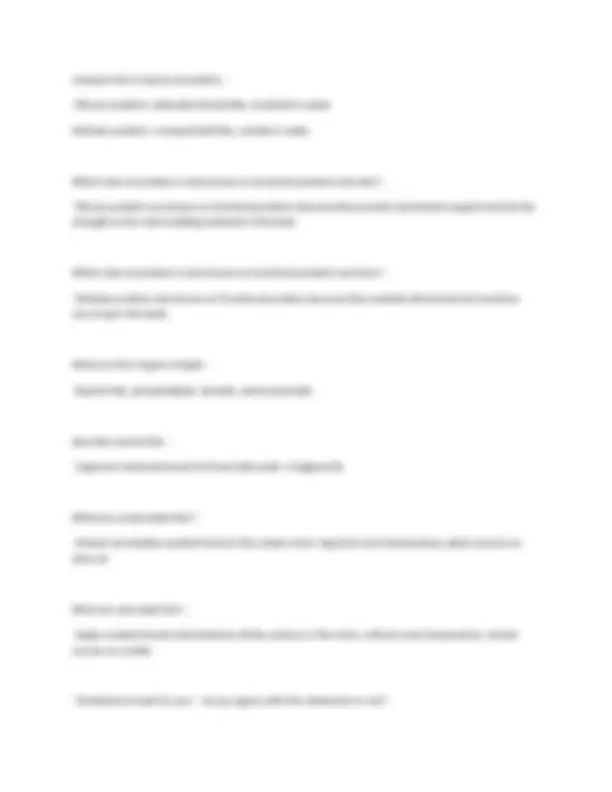
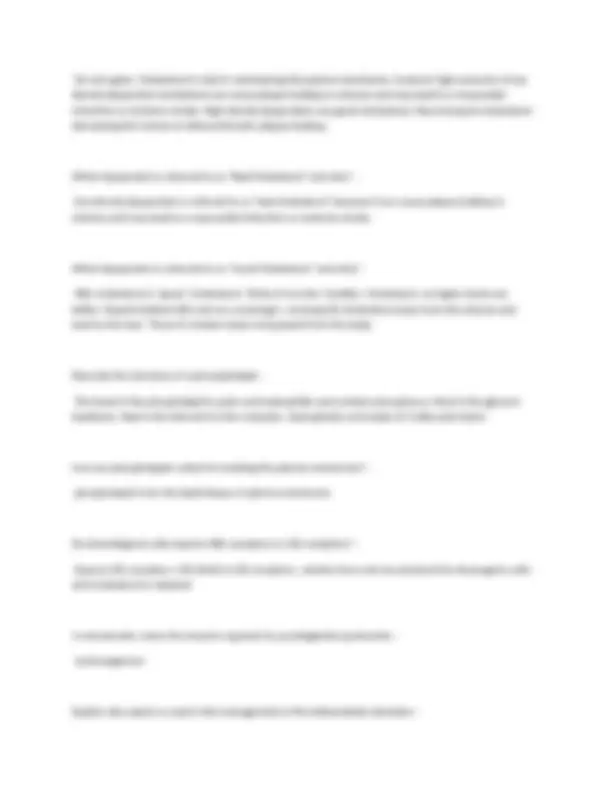
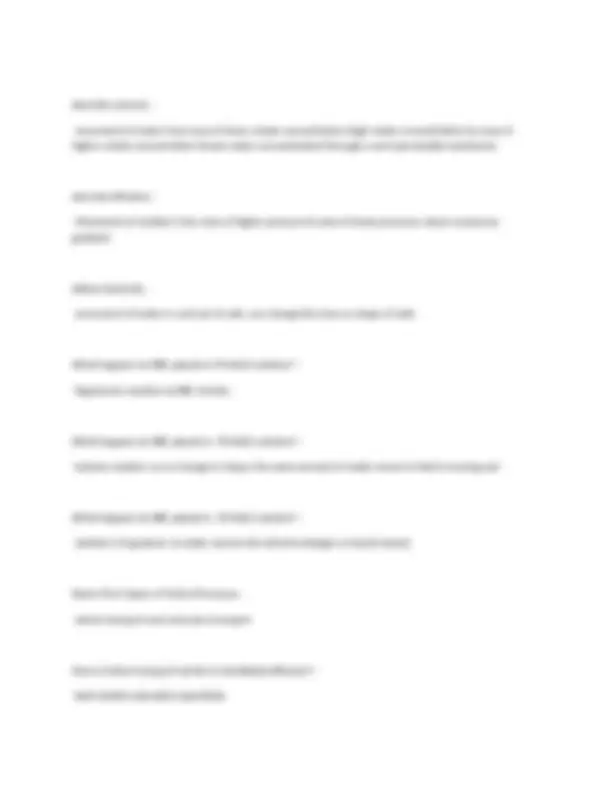
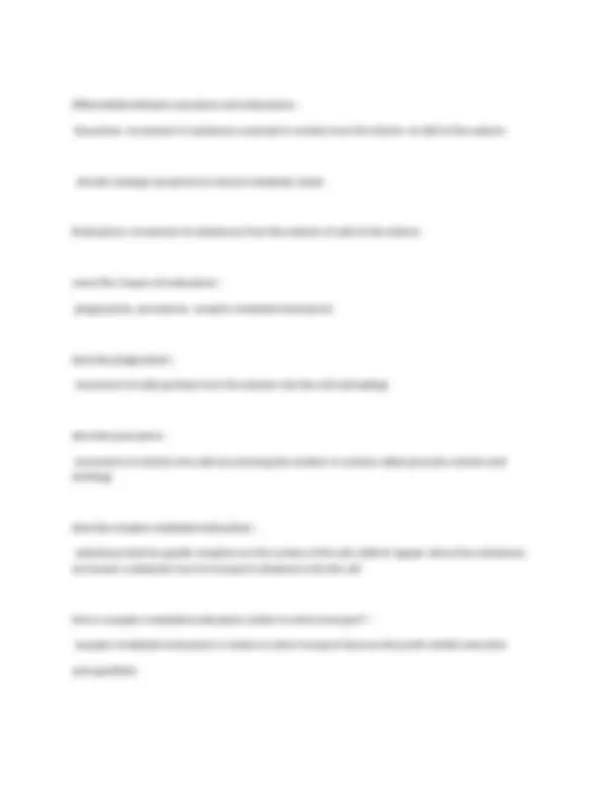
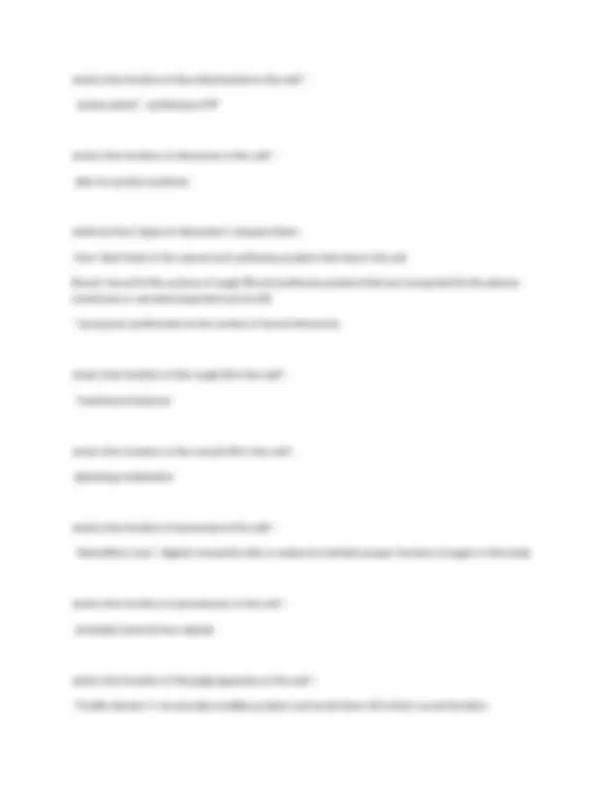
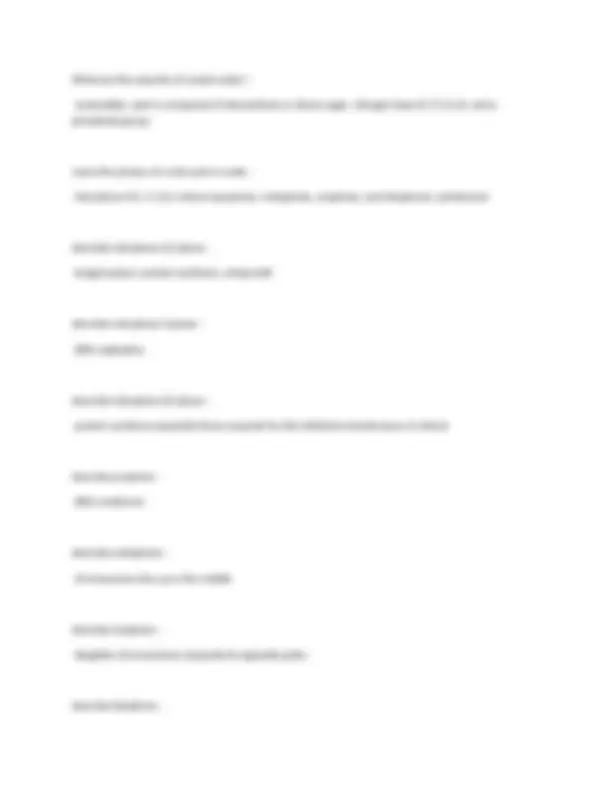
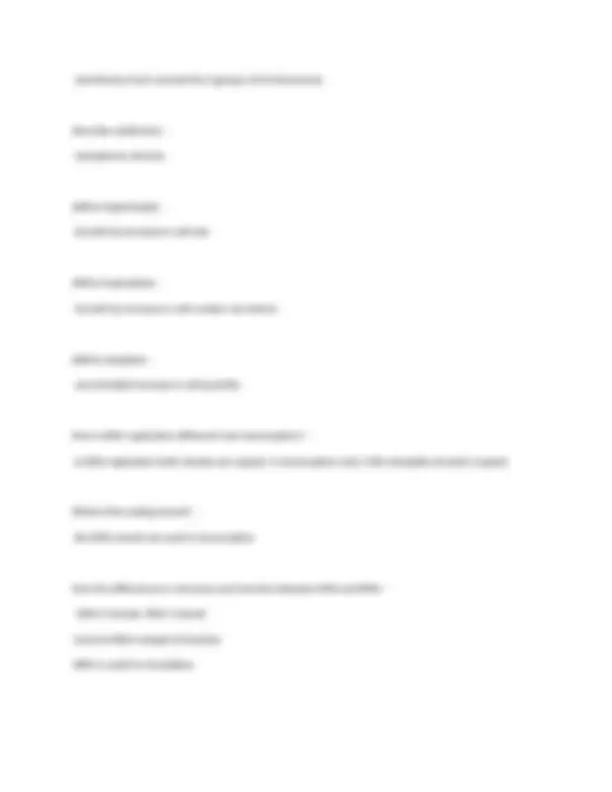
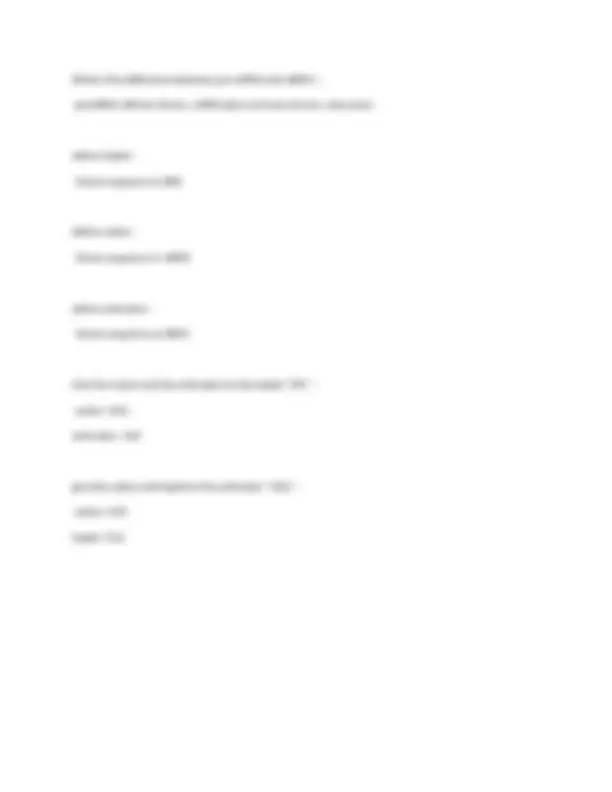


Study with the several resources on Docsity

Earn points by helping other students or get them with a premium plan


Prepare for your exams
Study with the several resources on Docsity

Earn points to download
Earn points by helping other students or get them with a premium plan
Community
Ask the community for help and clear up your study doubts
Discover the best universities in your country according to Docsity users
Free resources
Download our free guides on studying techniques, anxiety management strategies, and thesis advice from Docsity tutors
Exam 1 with Answer Key for Human Anatomy and Physiology I | BSCI 201
Typology: Exams
1 / 20

This page cannot be seen from the preview
Don't miss anything!













Define anatomy - the study of the parts of the body and how they relate to each other define physiology - the study of the function of the body's parts define homeostasis - maintenance of a relatively stable internal conditions even though the external environment it changing which organ systems are required for homeostasis - 10 of the 11 organ systems are required to maintain homeostasis (excludes reproductive system because it is not required, is present at birth but does not become functional until 10-12 years post- natal) Explain the statement "structure defines function" - The shape or composition of a certain thing determines how it will operate. what are the 2 main body cavities? - dorsal cavity and ventral cavity what does the dorsal cavity consist of? - consists of the cranial and vertebral cavities
what does the ventral cavity consist of? - consists of the thoracic and abdominopelvic cavities Describe the human body in anatomical position - -body is erect -feet slightly apart -palms face forward -thumbs point away from the body name the three planes of reference in dissection - -frontal (coronal) plane -midsagittal plane -transverse plane describe the frontal (coronal) plane - a longitudinal plane that divides the body (or an organ) into anterior and posterior parts describe the midsagittal plane - a longitudinal plane that divides the body into (equal) right and left parts describe the transverse plane - a horizontal plane that divides the body (or organ) into superior and inferior parts If you would like to observe the anatomical relationship between the heart and the lungs in vivo, which plane would you use in the dissection? -
describe the organ system level - organ systems consist of different organs that work together closely describe the organismal level - contains multiple organ systems, the human organism is made up of 11 organ systems define protons - positive charged particles in nucleus define neutrons - neutrally charged particles in nucleus define electrons - negatively charged particles, located in orbital around nucleus What is the overall charge of the atomic nucleus? - Overall charge of the atomic nucleus is positive because it houses the protons and neutrons What is the net charge of an atom? - When you subtract the number of electrons from the number of protons name the 3 types of chemical bonds and order them from weakest to strongest - hydrogen bond, ionic bond, covalent bond (nonpolar covalent is stronger than polar covalent)
describe the hydrogen bond - forms between 2 hydrogen atoms describe the ionic bond - complete transfer of electrons from one atom to another resulting in charged particles called ions (cation and anions) describe the covalent bond - electrons are shared between atoms to attain stability what is a polar covalent bond? - unequal sharing of electrons between atoms what is a nonpolar covalent bond? - electrons are shared equally between atoms (strongest bond) Give an example of a polar covalent molecule - water What are inorganic compounds? - Inorganic compounds do not contain carbon chains (except carbon dioxide and carbon monoxide) Name the 4 types of inorganic compounds - water, acids, bases, salts
name the 4 types of organic compounds - carbohydrates, lipids, proteins, nucleic acids describe carbohydrates - contains sugar and starches, provides body with quick energy describe lipids - hydrophobic substances insoluble in water, provides body with long term energy storage describe proteins - composed of one or more long chains of amino acids and are an essential part of all living organisms, especially as structural components of body tissues such as muscle, hair, collagen, etc. describe nucleic acids - a complex organic substance present in living cells, especially DNA or RNA, whose molecules consist of many nucleotides linked in a long chain (A,T,C,G,U) Give the composition of the 3 types of disaccharides - Maltose (glucose and glucose) Sucrose (glucose and fructose) Lactose (glucose and galactose) What are polysaccharides? - storage form of glucose, composed of long chains of glucose, known as starch in plants and GLYCOGEN in animal cells Are polysaccharides soluble or not? -
NOT soluble in water due to size and polymeric character Name the 4 structural levels of proteins - primary structure, secondary structure, tertiary structure, quarternary structure Describe the primary structural level of proteins - linear polypeptide chain, indicates the type and position of amino acids Describe the secondary structural level of proteins - 2 types: alpha helix- coiled polypeptide chain held together by hydrogen bonds beta pleated sheet- polypeptide chains linked side by side by hydrogen bonds Describe the tertiary structural level of proteins - secondary structure fold upon themselves to give a compact globular molecule; 3-dimensional structure held together by hydrogen bonds Describe the quarternary structural level of proteins - 2 or more polypeptide chains are held together by disulfide bonds Name the two types of secondary level of structural modification of proteins - Alpha helix coiled and beta pleated sheet What are the 2 classes of proteins? - fibrous proteins and globular proteins
Do not agree. Cholesterol is vital in maintaining the plasma membrane, however high amounts of low density lipoprotein cholesterol can cause plaque buildup in arteries and may lead to a myocardial infarction or ischemic stroke. High density lipoproteins are good cholesterol, they transport cholesterol decreasing the chance of atheroscherotic plaque buildup. Which lipoprotein is referred to as "Bad Cholesterol" and why? - low density lipoprotein is referred to as "bad cholesterol" because it can cause plaque buildup in arteries and may lead to a myocardial infarction or ischemic stroke Which lipoprotein is referred to as "Good Cholesterol" and why? - HDL cholesterol is "good" cholesterol. Think of it as the "healthy" cholesterol, so higher levels are better. Experts believe HDL acts as a scavenger, carrying LDL cholesterol away from the arteries and back to the liver. There it's broken down and passed from the body. Describe the structure of a phosopholipid - The head of the phospholipid is polar and hydrophillic and contains phosphorus. Next is the glycerol backbone. Next is the tail and it is the nonpolar, hydrophobic end made of 2 fatty acid chains. how are phospholipids suited for building the plasma membrane? - phospholipids form the lipid bilayer of plasma membrane Do steroidogenic cells express HDL receptors or LDL receptors? - Express LDL receptors. LDL binds to LDL receptors, vesicles form and are pinched into stereogenic cells and cholesterol is released In eicosanoids, name the enzyme required for prostaglandin production. - cyclooxygenase Explain why aspirin is used in the management of thromboembolic disorders -
aspirin inhibits cyclooxygenase (cox) hence prostaglandins are not synthesized and thus hemostasis results and blood clot formation does not occur what is a cell? - structural and functional units of all living organisms Name the 3 major parts of the cell - -Plasma membrane -Nucleus -cytoplasm What is the function of cholesterol in the plasma membrane? - Cholesterol provides the cell membrane with structural support due to rigid composition. Also plays important role in containing the fluid inside the cell membrane Differentiate between integral and peripheral proteins - integral proteins are permanently imbedded within the lipid bilayer, peripheral proteins are temporarily bound to lipid bilayer/integral proteins What are transmembrane proteins? - crosses the entire membrane and protrudes on both sides name the 3 types of membrane junctions - tight junction, gap junction, desmosome Describe the tight junction -
describe osmosis - movement of water from area of lower solute concentration (high water concentration) to area of higher solute concentration (lower water concentration) through a semi-permeable membrane describe filtration - Movement of solution from area of higher pressure to area of lower pressure; down a pressure gradient. define tonicicity - movement of water in and out of cells, can change the tone or shape of cells What happens to RBC placed in 9% NaCl solution? - Hypertonic solution so RBC shrinks What happens to RBC placed in .9% NaCl solution? - isotonic solution so no change in shape, the same amount of water moves in that is moving out What happens to RBC placed in .3% NaCl solution? - solution is hypotonic so water moves into cell and enlarges or bursts (lyses) Name the 2 types of Active Processes - active transport and vesicular transport How is Active transport similar to facilitated diffusion? - both exhibit saturation/specificity
Differentiate between exocytosis and endocytosis - Exocytosis: movement of substances enclosed in vesicles from the interior of cells to the exterior -all cells undergo exocytosis to remove metabolic waste Endocytosis: movement of substances from the exterior of cells to the interior name the 3 types of endocytosis - phagocytosis, pinocytosis, receptor-mediated endocytosis describe phagocytosis - movement of solid particles from the exterior into the cell (cell eating) describe pinocytosis - movement of solution into cells by enclosing the solution in vesicles called pinocytic vesicles (cell drinking) describe receptor-mediated endocytosis - substances bind to specific receptors on the surface of the cell; clathrin appear where the substances are bound; coated pits form to transport substances into the cell How is receptor-mediated endocytosis similar to active transport? - receptor-mediated endocytosis is similar to active transport because they both exhibit saturation and specificity
Describe two structures that will be prominent in a protein-secreting cell? - ribosomes and golgi apparatus Which organelle is involved in drug detoxification and steroid hormone synthesis? - Smooth ER Name the 3 types of cytoskeleton - microtubules, intermediate filaments, microfilaments describe microtubules - largest diameter of cytoskeleton, form centrioles, form tracks inside cytosol for vesicular trafficking, form cillia and flagellaum describe intermediate filaments - medium diameter, cables of tough, insoluble fibrous protien fibers that resist tension placed on cells describe microfilaments - smallest diameter of cytoskeleton, Involved in contraction, the formation of cleavage furrow during cytokinesis, and the changes of the plasma membrane during endocytosis and exocytosis, composed of actin What is the structural difference between cilia and flagella? - cilia occurs in large numbers on surface of cells and the flagellum (in the quantity of 1) extends from the sperm cell What is the functional difference between cilia and flagella? -
cilia beat to create unidirectional currents that propels substances across the surface of cells and flagellum beat to propel the sperm cell Name the 3 distinct parts of the nucleus - Nuclear envelope (membrane), Nucleolus, Chromatin Explain why a phagocyte will have several nucleoli in its nucleus - Nuclei is the site for assembling ribosomal subunits which synthesize lysozymes which are needed for phagocytosis What are nucleosomes? - structural units of chromatin, each is composed of 8 globular histone proteins connected by the thread- like DNA Discuss 2 functions of histone proteins - Histone proteins acts as structural framework of support for DNA & control the activities of DNA What are the 2 types of chromatin? - euchromatin and heterochromatin Describe euchromatin - DNA extended, unravelled from histone proteins, active form of chromatin Describe heterochromatin - DNA attached to histone proteins, hence DNA is coiled, inactive form of chromatin
membranes form around the 2 groups of chromosomes describe cytokinesis - Cytoplasmic division define hypertrophy - Growth by increase in cell size define hyperplasia - Growth by increase in cell number via mitosis define neoplasia - uncontrolled increase in cell quantity How is DNA replication different from transcription? - in DNA replication both strands are copied, in transcription only 1 (the template strand) is copied What is the coding strand? - the DNA strand not used in transcription Give the differences in structure and function between DNA and RNA - -DNA 2 strands, RNA 1 strand -Uracil in RNA instead of thymine -RNA is used for translation
What is the difference between pre-mRNA and mRNA? - premRNA still has introns, mRNA does not have introns, only exons define triplet - 3-base sequence in DNA define codon - 3-base sequence in mRNA define anitcodon - 3-base sequence on tRNA Give the codon and the anticodon to the triplet "ATC" - codon- UAG anticodon- AUC give the codon and triplet to the anticodon "UGA" - codon- ACU triplet- TGA